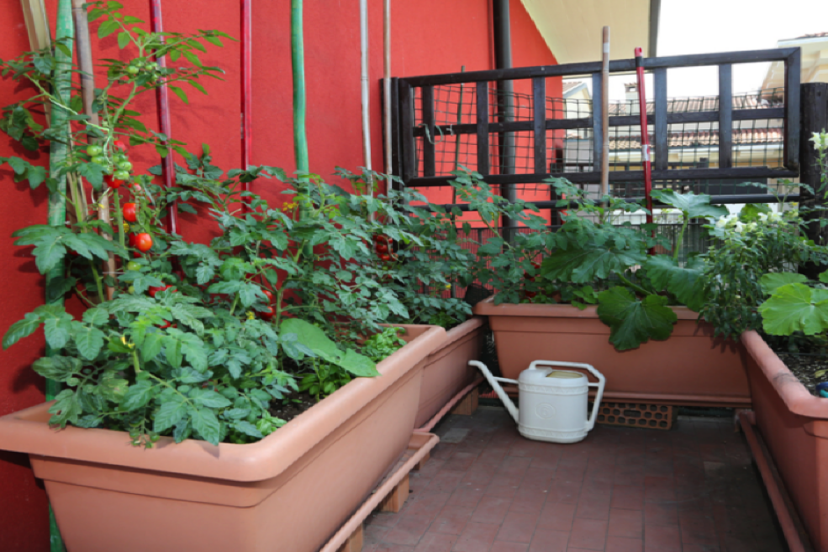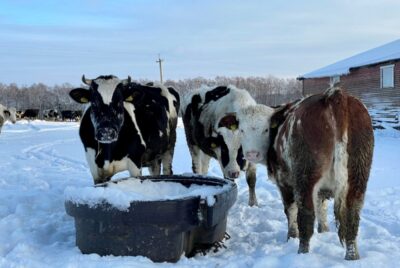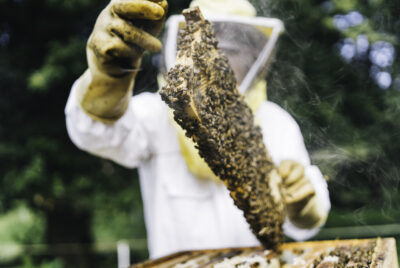Container Gardening: Growing a Bountiful Harvest in Small Spaces
"We may earn a commission from purchases made using our links. Please see disclaimer."
Introduction to Container Gardening
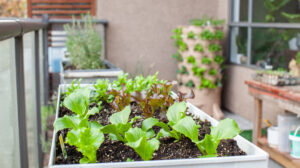 Growing a productive vegetable garden or a colorful array of flowers and foliage is possible even if you don’t have a spacious backyard or any land at all. With container gardening, you can cultivate your green thumb and grow beautiful plants on patios, balconies, rooftops, and other small outdoor spaces.
Growing a productive vegetable garden or a colorful array of flowers and foliage is possible even if you don’t have a spacious backyard or any land at all. With container gardening, you can cultivate your green thumb and grow beautiful plants on patios, balconies, rooftops, and other small outdoor spaces.
As a devoted container gardener myself, I want to share my best tips and suggestions to get you started and help ensure your container plants thrive all season long. Keep reading to learn the benefits of container gardening, what to consider before getting started, and my top recommendations for containers, soil mixes, plant selections, maintenance, and more!
Benefits of Container Gardening
There are so many great reasons to give container gardening a try:
- Works anywhere: Containers allow you to grow plants whether you live in an apartment, condo, townhouse, or other space without a yard. As long as you have a sunny outdoor area, you can do container gardening.
- Complete control: With containers, you can customize the soil mix, fertilizer schedule, and every other growing condition to perfectly suit your chosen plants. This allows you to grow plants that require specific needs.
- Easy access: The plants are right at your fingertips for convenient harvesting, pruning, and care. You don’t have to dig or weed.
- Size flexibility: You can do small-scale container gardens up to large expansive ones. Scale up or down to suit your space and needs.
- Portability: It’s simple to rearrange containers or even move them indoors or to a new home. Gardens in the ground are fixed in place.
- Height options: Certain containers like vertical planters allow you to grow upward and maximize space.
- Neat appearance: Contained plants look tidy and decorative on patios and porches. You avoid messy in-ground beds.
Things to Consider Before Starting Container Gardening
While the benefits are numerous, container gardening does have some key considerations:
- Container plants need more frequent watering than in-ground plants. Be prepared to water at least once daily, sometimes twice when it’s hot.
- Fertilizing is also crucial since containers have a limited soil supply. You’ll need to feed plants regularly.
- The containers must have drainage holes and lightweight potting mix that won’t get waterlogged.
- Make sure you have enough space and sun exposure for the containers you want to use.
- Some container plants like tomatoes require large pots (10+ gallons).
If you keep these factors in mind, container gardening can be very rewarding! Let’s go over the process step-by-step.
Choosing the Right Containers
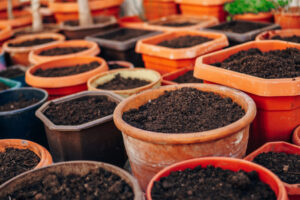 The containers themselves are one of the most important elements. You want containers that will support healthy plant growth and stand the test of time. The right containers are essential for both the long-term viability of your growing system and the health of your plants. Prioritize non-porous materials like plastic or vinyl over terra cotta, which allows water to seep through over time. Seek out food-grade, BPA-free containers made specifically for aquaponics growing to ensure no toxins leach into your system. Consider durability, stability, size proportions, and seam strength when selecting containers.
The containers themselves are one of the most important elements. You want containers that will support healthy plant growth and stand the test of time. The right containers are essential for both the long-term viability of your growing system and the health of your plants. Prioritize non-porous materials like plastic or vinyl over terra cotta, which allows water to seep through over time. Seek out food-grade, BPA-free containers made specifically for aquaponics growing to ensure no toxins leach into your system. Consider durability, stability, size proportions, and seam strength when selecting containers.
Material Options for Containers
Here are suitable container material options:
- Plastic: Affordable and durable but can fade and become brittle over time when exposed to sun and weather.
- Ceramic/terra cotta: Pretty but breakable and prone to cracking. They dry out rapidly.
- Wood: Attractive and eco-friendly but requires yearly sealing to prevent rotting.
- Metal: Long-lasting, but metal heats up rapidly in the sun.
- Resin: Lightweight and weather-resistant but more expensive.
- Fabric: Breathable and inexpensive but less sturdy and durable.
For versatility and longevity, I recommend plastic resin or wood containers. Terra cotta and ceramic work well for small pots.
Size and Depth Considerations
When selecting your containers, make sure they are an adequate size and depth for your chosen plants. Here are my recommendations:
- Large vegetables: At least 10-15 gallon pots, minimum 1 ft deep. Examples: tomatoes, peppers, eggplant.
- Leafy greens: Minimum 5-gallon pots, 8-10 inches deep. Examples: lettuce, kale, spinach.
- Herbs and flowers: 3-7 gallon pots depending on plant size, at least 8 inches deep.
- Shallow-rooted plants: Minimum 5-gallon pots. Examples: radishes, strawberries.
Bigger is often better when it comes to container gardening! Having room for roots to spread out helps plants grow vigorously.
Drainage Requirements
Excellent drainage is mandatory for container gardening success. Each container must have drainage holes in the bottom to prevent waterlogging. Here are some best practices:
- Choose containers with built-in drainage holes, or drill adequate holes in the bottom yourself.
- Elevate containers slightly off the ground using “feet” or spacers. This improves drainage.
- Put a layer of coarse gravel, old shards, or styrofoam peanuts at the bottom before adding soil.
- Avoid external saucers under pots, as they prevent drainage.
Follow these tips, and you won’t have to worry about overly soggy soil! Proper drainage keeps container plants happy.
Selecting the Right Soil Mix 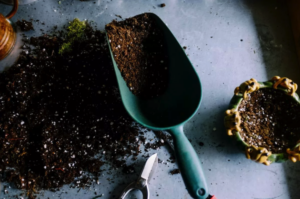
A high-quality container soil mix gives plants the moisture, nutrients, and drainage they need in a limited space.
You have two main options: store-bought mixes or homemade.
Store-bought vs. DIY Mixes
Store-bought mixes are available at garden centers or hardware stores. Look for all-purpose blends formulated specifically for containers. They provide an ideal blend of soil, organic matter, and amendments.
DIY mixes allow you to customize but require sourcing and measuring ingredients yourself. You may already have some on hand. DIY mixes work well but are more labor-intensive.
I personally like using store-bought container mixes for simplicity, but follow your preference! Whichever route you choose, certain key ingredients are vital…
Key Ingredients for Container Soil
- Lightweight base: Options like peat moss, coco coir, perlite, vermiculite. Improves drainage and aeration.
- Rich organic matter: Compost, leaf mold, well-rotted manure. Provides nutrients for plants and beneficial microbes.
- Soil: Look for loamy garden soil or potting mix, not heavy clay soil which compacts.
- Fertilizer: Granular, slow-release fertilizer provides a steady supply of nutrients.
- pH adjuster: Dolomitic lime for acidic soil or sulfur for alkaline soil. Most plants prefer a slightly acidic pH of around 6.5.
Follow package instructions for store-bought mixes. For DIY mixes, do a 1:1:1 ratio of lightweight base, organic matter, and soil as a simple starting point. Mix in fertilizer and pH adjuster according to soil test results.
Choosing the Right Plants

Not all plants adapt well to container-growing conditions. Focus on plants that are compact, tolerant of dry spells, and fine with confined root spaces. When selecting plants for an aquaponics system, prioritize fast-growing leafy greens and herbs like lettuce, spinach, basil, and chives. These plants thrive with consistent moisture and nutrients provided in aquaponics. Consider spacing and sunlight needed to allow proper growth.
Herbs and Vegetables That Thrive in Containers
Here are some of my top herb and vegetable recommendations:
- Herbs: Virtually all culinary herbs do splendidly in pots – try basil, parsley, oregano, thyme, sage, rosemary, cilantro, and mint.
- Leafy greens: Lettuce, spinach, kale, swiss chard, arugula, microgreens. Go for compact, quick-growing varieties.
- Cherry tomatoes: Delicious and prolific in hanging baskets or 5-gallon pots. Look for patio or container-specific varieties.
- Peppers: Compact varieties like ‘Munchkin’ peppers produce well in 5-10 gallon containers.
- Eggplant: The slender Asian eggplant varieties are perfect for containers. ‘Little Fingers’ is a winner.
- Radishes and carrots: Great for shallow pots, best for spring and fall growing. Opt for short-rooted varieties.
- Bush beans and peas: Choose compact, bush-habit beans and dwarf pea varieties. Provide trellising.
- Strawberries: Evergreen or alpine strawberries thrive in hanging baskets and small pots.
Flowers and Foliage Plants for Pots
Beyond edibles, almost any flowering plant or foliage looks lovely in containers. Some of my personal favorites include:
- Petunias: Offer dazzling color and bloom all season long. Great for pots, window boxes, and hanging baskets.
- Geraniums: Available in a wide range of colors. Heat and drought tolerant once established.
- Sunpatiens: Vigorous impatiens that flourish in sun or shade and resist diseases.
- Coleus: Colorful foliage comes in endless combinations. Does well in shade.
- Million bells: Prolific trailing calibrachoa with tiny petunia-like blooms. Perfect for cascading over pot edges.
- Purple fountain grass: Eye-catching spiky texture. Looks fantastic in grouped containers.
Mix flowers, foliage, and edible plants together in containers for multifunctional beauty. The possibilities are endless!
Caring for Container Plants
The confined spaces of containers mean plants need more frequent care and maintenance to thrive. Don’t let that intimidate you – just stick to a routine and your plants will flourish!
Watering Best Practices
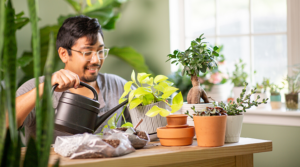 Consistent watering is key, especially with porous container soil that dries out readily. Check soil moisture daily. Water whenever the top 1-2 inches becomes dry. Established plants need deep watering until they drains from the base.
Consistent watering is key, especially with porous container soil that dries out readily. Check soil moisture daily. Water whenever the top 1-2 inches becomes dry. Established plants need deep watering until they drains from the base.
Here are some tips to follow:
- Morning watering allows plants to hydrate through the hot afternoons.
- Group containers together to simplify watering.
- Add water until it drains from the bottom to encourage deep roots.
- Customize watering for each plant – bigger and sunnier pots need more frequent watering.
Fertilizing Recommendations
Container plants quickly deplete nutrients from the limited soil mix. Fertilize them regularly to maintain vigorous growth:
- Use either slow-release granular fertilizer or a liquid feed like fish emulsion. Follow label directions.
- Fertilize at full strength every 2-4 weeks during the active growing season.
- Reduce fertilizer during cool weather and growth lulls to avoid buildup.
- Watch plants for signs of nutrient deficiencies like yellowing leaves or stunted growth. Increase fertilizer if needed.
- For flowering plants, use formulations higher in phosphorus to promote blooms.
Pruning and Deadheading Tips
- Pruning and deadheading are easy with container plants right at your fingertips:
- Prune overgrown or damaged foliage and stems as needed to maintain an attractive shape.
- Pinch off spent blooms on flowering plants to encourage continuous new buds.
- Cut back herbs like basil frequently to stimulate bushy new growth. They will regrow quickly.
- Thin overcrowded seedlings to allow proper development of remaining plants.
- Spread out or trim back plants that outgrow their pots. Transplant them to larger containers if needed.
Stay on top of pruning, and your container plants will continue producing growth and flowers all season!
Overwintering Container Plants
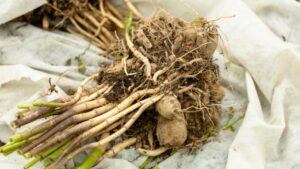 One extra consideration with container gardening is overwintering tender plants for next year. You have a couple of options to keep them alive through winter. When overwintering container plants, first determine which plants can withstand your climate’s winter conditions and which need extra protection. For cold-sensitive potted plants, overwinter them indoors near a sunny window, provide grow lights to supplement natural light, water when soil is partly dry, and maintain temperatures above 55°F. You can also overwinter container plants in a greenhouse or cold frame if temperatures remain above freezing.
One extra consideration with container gardening is overwintering tender plants for next year. You have a couple of options to keep them alive through winter. When overwintering container plants, first determine which plants can withstand your climate’s winter conditions and which need extra protection. For cold-sensitive potted plants, overwinter them indoors near a sunny window, provide grow lights to supplement natural light, water when soil is partly dry, and maintain temperatures above 55°F. You can also overwinter container plants in a greenhouse or cold frame if temperatures remain above freezing.
Moving Containers Indoors
- Select compact plants in their own pots to move inside before fall frosts hit.
- Find a bright, sunny indoor spot like a sunny windowsill or under grow lights.
- Transition plants slowly over a week or two to adapt them before bringing them inside full time.
- Monitor watering carefully – plants need less frequent watering indoors. Let the soil dry out further between waterings.
Storing Tender Plants for Next Year
- Dig up annuals like dahlias, canna lilies, and begonias before a hard freeze.
- Allow the soil to dry then cut back foliage. Store the bulbs and tubers in a cool dark place like a basement or garage.
- In spring, replant the overwintered bulbs in fresh potting mix after the last expected frost. They will resume growing quickly.
- Overwinter hardy perennials like rosemary and geraniums easily in their original containers. Bring them inside for winter before moving them back out next spring.
With a bit of preparation, you can save many beautiful container plants year after year!
Troubleshooting Common Container Gardening Issues
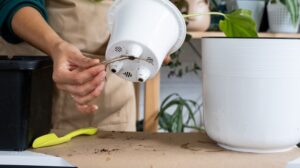 Even experienced container gardeners run into problems occasionally. Don’t get discouraged! Many common issues are easily remedied. When troubleshooting container garden problems, first identify the symptoms appearing and rule out obvious causes like inconsistent watering, drainage issues, pest damage, or inadequate sunlight. Look for solutions tailored to your specific container type, plants selected, and environment such as adjusting soil pH for potting mix containers, reducing watering frequency for self-watering planters, or applying integrated pest management. With some targeted troubleshooting and adaptive care, most common container gardening problems can be corrected.
Even experienced container gardeners run into problems occasionally. Don’t get discouraged! Many common issues are easily remedied. When troubleshooting container garden problems, first identify the symptoms appearing and rule out obvious causes like inconsistent watering, drainage issues, pest damage, or inadequate sunlight. Look for solutions tailored to your specific container type, plants selected, and environment such as adjusting soil pH for potting mix containers, reducing watering frequency for self-watering planters, or applying integrated pest management. With some targeted troubleshooting and adaptive care, most common container gardening problems can be corrected.
Dealing with Pests
Aphids, spider mites, and other sap-sucking insects can build up rapidly on container plants. Here are some organic remedies:
- Knock pests off with a strong spray of water from the hose. Repeat frequently to disrupt their lifecycle.
- Apply insecticidal soap or neem oil per label instructions to smother and deter pests.
- Remove badly-infested foliage or whole plants to prevent further spreading.
- Introduce ladybugs and other beneficial predators to naturally control pests.
Preventing and Treating Diseases
Watering properly is key to avoiding disease, along with these tips:
- Improve air circulation and avoid crowding plants to reduce humidity and fungus problems.
- Apply organic fungicides at the first sign of leaf spot or powdery mildew diseases.
- Remove and destroy diseased material immediately to prevent spreading.
- Sanitize containers and tools thoroughly with a bleach solution between uses.
With quick action, you can remedy issues and get your container garden thriving once again!
Conclusion & FAQs
I hope these container gardening tips give you the foundation and inspiration to get growing! With the right containers, soil, plant selections, and care, you can create a beautiful bountiful container garden anywhere. Keep fine-tuning your practices each season as you gain experience. Don’t get discouraged by setbacks. With a bit of patience and persistence, you can get a harvest of delicious homegrown vegetables and herbs alongside gorgeous flowering container plants.
If you’re thinking about starting container gardening, here are answers to some frequently asked questions:
1. What size containers are best to start with?
I suggest a combination of small and larger pots. Try a few bigger 15-25 gallon containers for plants like tomatoes and peppers paired with an assortment of 3-7 gallon containers for herbs, greens, and flowers. Having a range allows flexibility.
2. How much sun do container plants need?
Most edibles and flowering plants need at least 6-8 hours of direct sun daily. Position them in the sunniest available spaces. Leafy greens and shade-loving flowers can handle partial sun.
3. Can I grow vegetables and flowers together?
Absolutely! Mixed planters create diversity and visual interest. Just be sure to use larger containers to provide room for proper growth.
4. How often do containers need to be watered?
Check soil daily, and water whenever the top few inches become dry. Most containers need watering at least once a day in hot weather.
5. What are the signs my plants need more fertilizer?
Stunted growth, yellowing leaves, or lackluster flowers can indicate hungry plants. Increase fertilizer per label rates if you see deficiency signs.
Let me know if you have any other container gardening questions! I’m always happy to help new gardeners get started and have success with this fun, rewarding hobby.


